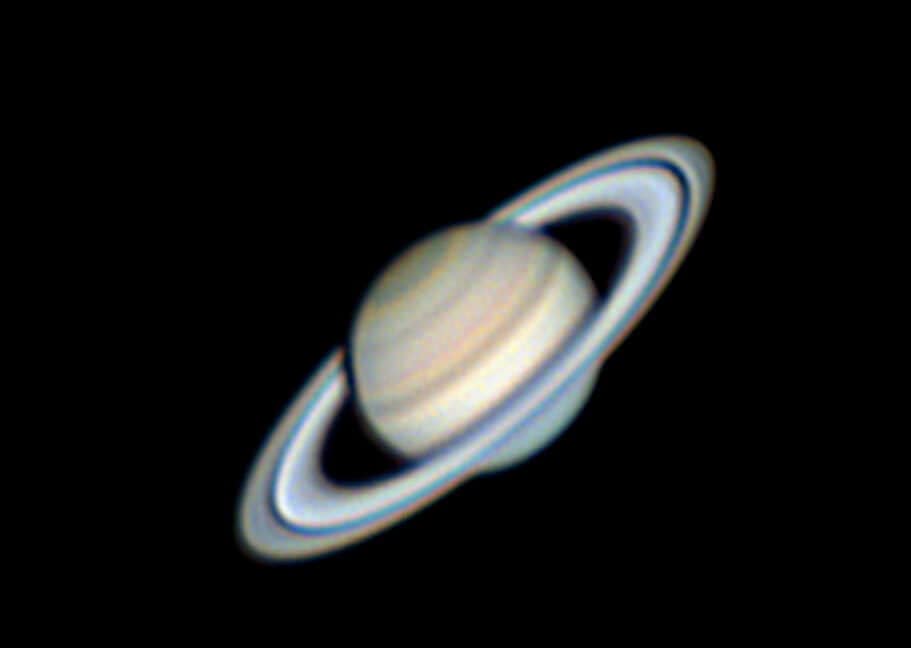Unlike its terrestrial counterparts, such as Earth, Saturn lacks a solid outer layer. The visible region we perceive as its “surface” actually consists of its cloud cover.
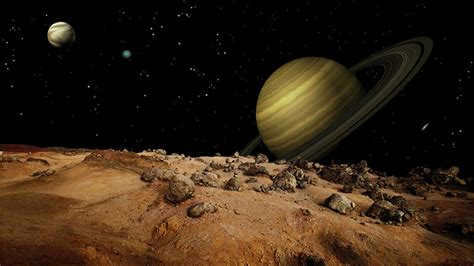

Table of Contents
- Which celestial body is not visible to the naked eye?
- Which planet is the most visible from Earth?
- What is the astronomical object that appears beside the Moon?
- Is it possible to observe the Moon through a telescope?
- How can one differentiate between a planet and a star?
- Mercury. Mercury is the planet closest to the Sun.
- Venus. Venus, also known as the evening star, is one of the brightest objects in the night sky.
- Earth.
- Mars.
- Jupiter.
- Saturn.
- Uranus.
- Neptune.
- Dark yellow (15) and orange (21) filters are suitable for emphasizing the planet’s bands, zones, and their intricate details (for telescopes with a 200mm diameter, dark red (25) can be an alternative option);
- Yellow (11) filter – for highlighting green and reddish features;
- Green (58) filter – for better visibility of spots and polar regions;
- Blue (80A) filter – for capturing more details of Saturn’s rings (for larger lenses, it might be advisable to use blue (38A) or violet-blue (47) filters).
- By using dark yellow and orange filters, you can highlight the belts and zones present in Saturn’s atmosphere.
- If you opt for a yellow filter, you’ll be able to clearly see the green and reddish tones.
- When observing the polar regions, individual zones, and belts, a green filter can greatly improve visibility.
- If you’re interested in the rings, a blue filter can provide good detail. However, for more powerful telescopes, it’s recommended to use blue and violet-blue filters.
- The planet is at its farthest point from the Sun in our sky, with a 180° angle between the luminaries, creating an opposition.
- Saturn’s visibility is at its peak for the year, rising at sunset and setting behind the horizon at dawn, making it visible all night.
- The planet appears at its largest size, providing optimal conditions for observation through a telescope.
- Saturn’s brightness is at its maximum, making it easily identifiable in the sky.
The naked eye can observe the planet, although it appears as a bright dot. However, by using a telescope with a 100 mm aperture, one can see the disk of Saturn along with its rings.
Is it possible to view Saturn from Earth without any aids?
A total of 6 planets, including Mercury, Venus, Mars, Jupiter, Saturn, and occasionally Uranus, can be observed in the sky with the naked eye.
Can Saturn be currently observed?
Where is Saturn located in the sky at this moment? Currently, Saturn is situated below the horizon within the Capricorn constellation. Tomorrow, it will become visible in the east-southeast at 09:23. The graph displays the altitude of Saturn above the horizon (-, °) as a function of the time of day. The shaded regions () represent the nighttime, while the dashed line (—) indicates the present time.
Which planet is considered the most perilous in the universe?
| Longitude of the ascending node ( Ω) | 113,642 811° |
| Pericenter argument ( ω) | 336,013 862° |
| Orbiting around | The Sun |
| Number of Satellites | 83 |
Can you observe Saturn using a pair of binoculars?
It may sound unbelievable, but you can actually view Saturn even with the help of binoculars. Admittedly, you won’t be able to make out the intricate details of the planet and its moons, and the rings will only appear as small extensions on its sides. Nonetheless, the fact remains that Saturn is visible to the naked eye without the aid of a telescope.
Which celestial body cannot be observed?
In terms of its astronomical features, this particular celestial body is rarely visible in the night sky, especially at higher latitudes, with the exception of certain instances such as during eclipses. After sunset, there is only a brief window of opportunity to catch a glimpse of Mercury.
Which celestial body offers the best visibility from our planet?
Mercury, Venus, Mars, Jupiter, and Saturn can all be easily seen without the aid of any optical instruments (telescopes are required to observe Uranus and Neptune). Among them, Venus shines the brightest due to its relatively large size, close proximity to Earth, and its highly reflective white cloud-filled atmosphere.
Which celestial body can be observed at night from Earth?
Even within the confines of a city, the naked eye can still discern these celestial bodies in the night sky, with Jupiter being the brighter of the two and Saturn positioned to its left.
Which celestial bodies can be seen without any optical aids from Earth?
In the evening sky during January, the naked eye can spot four planets: VENERA (m= – 3.9)*, JUPITER (m= -2.2), MARS (m= -0.7), and SATURN (m= +0.8).
Is it possible to see Saturn without the aid of a telescope?
There are a total of five planets that can be seen with the naked eye: Mercury, Venus, Mars, Jupiter, and Saturn.
Can a person stand on Saturn?
Something similar can be observed on Saturn, although it is not possible to stand on its surface: you would simply fall through since Saturn is a gas giant and not a solid planet.
What is the star next to the moon? Take note of the star Aldebaran (alpha Taurus, apparent magnitude m = +0.85) on the right and below the Moon, near the Hyades cluster. You can observe it with the naked eye or binoculars.
What celestial objects can be observed in the nighttime sky?
Which planet is currently visible near the Moon?
Which planet is in close proximity to the Moon today? Venus (planet) – Wikipedia, the free encyclopedia.
Which planet is suitable for sustaining life?
Earth is the sole planet known to harbor life. It possesses oxygen, a vital element for the sustenance of life. Furthermore, Earth holds the distinction of being the third planet from the Sun.
Which celestial body exhibits the slowest rotation?
The planet Venus holds the title for the slowest rotation, with its day surpassing the length of a year. On the other hand, Jupiter boasts the fastest rotation speed.
What makes the planet Saturn intriguing?
Saturn stands out as the farthest planet within our solar system that can be observed without any optical aid (note that Uranus requires exceptionally dark skies and good eyesight for visibility). Additionally, Saturn maintains an average distance of 1.4 billion kilometers from the Sun, completing one revolution around it in 29.5 years.
Which planet is currently visible in the sky?
Behold the planet Venus, not a star, now gracing the morning sky an hour or even slightly earlier than sunrise.
Is it possible to observe Mars using a telescope?
With a 60-millimeter telescope, it is already possible to see the small disk of Mars. However, the level of detail will be minimal, but it is still possible to confirm that the planet has a red color. For a more comprehensive study, it is recommended to use a Newtonian reflector telescope with a 150 mm objective lens diameter or a 100 mm refractor telescope.
Is it possible to observe the Moon using a telescope?
For amateur astronomers who are not professionals, one of the most accessible ways to explore the universe is by using a telescope to observe the Moon. The Moon, being a bright and relatively large celestial body, offers a fascinating experience when observed through the eyepiece of an amateur telescope. Details such as craters and mountains can be clearly seen, making it an enjoyable activity.
How many planets exist in our solar system?
| Number of confirmed planets | 8 |
| Number of dwarf planets | 5 |
| Number of satellites | 639 (204 for planets and 435 for small solar system bodies) |
| Number of small bodies | More than 1,000,000 (as of November 2020) |
Is it possible to see Jupiter during daylight?
Jupiter is located much further from the Sun. It is extremely challenging to observe it during daylight using the unaided eye and it appears significantly dimmer compared to Venus.
How can one distinguish between a planet and a star?
How can you differentiate between a star and a planet? Stars emit their own light, causing them to twinkle and their brightness to fluctuate. On the other hand, planets only reflect sunlight, resulting in a consistent brightness.
How can Mars be identified in the nighttime sky?
Mars is also a small planet, but its close proximity to the solar system ensures that it is always easily visible, unless it is obstructed by the Sun or below the horizon. Under these circumstances, it is simple to spot this radiant celestial body alongside the very luminous Venus or Jupiter.
Video: what is the process of observing Saturn?
Did our responses prove to be useful?
Trending in the past 24 hours

What type of currency bill is known to draw wealth?
As per ancient Chinese beliefs, the number eight is considered the most auspicious for attracting wealth, especially when it appears in the serial number.


Is there a reason why drawing on your wrist is not allowed?
What is the rationale behind Russians writing codes on their wrists? They use combinations of numbers in an attempt to induce illnesses P.

What is the purpose of writing numbers on one’s wrist?
Have you ever wondered why Russians write codes on their wrists? They believe that by using combinations of numbers, they can intentionally induce illnesses or ailments.

What types of paintings can bring good luck and fortune?
Paintings that can help attract money. In order to invite wealth and prosperity into your home, consider hanging paintings that depict and symbolize them.


What are the figures that bring wealth?
One of the most popular figures associated with attracting wealth is the three-toed toad sitting on a pearl and holding a coin in its mouth.

What kind of artwork should be displayed in the area associated with wealth?
Furthermore, it is important that the paintings which bring good fortune into a household portray either flowers or specifically a chrysanthemum flower.

What is the significance of drawing the infinity symbol on the hand?
Why is it important for everyone to draw it? This symbol has the power to bring positive energy to any environment.

What is the method to determine your luck code?
To find out your luck code, you need to calculate the sum of the numbers corresponding to the day, month, and year of your birth. Then, add up the obtained sum once again.
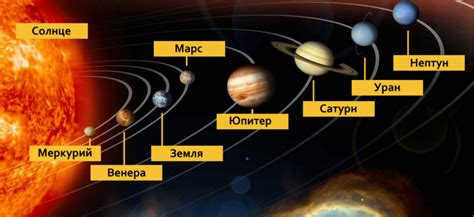

The planet that is fifth from the sun is Jupiter. It is located between Mercury, Venus, Earth, and Venus.
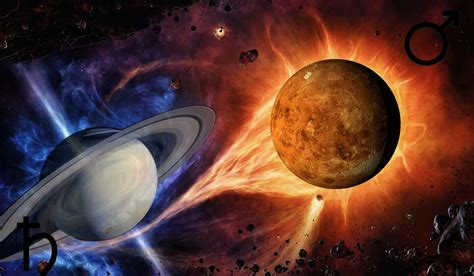
Which planet in the natal chart has influence over various aspects of a person’s life?
The position of Mercury signifies a person’s intellectual abilities, while Venus influences their sense of beauty.
The astronomer Galileo Galilei was the first to discover the planet Saturn and was fortunate enough to observe it through a telescope.
The story of Saturn’s discovery goes as follows: during the early 17th century, Galileo Galilei observed the planet through a telescope and noticed that it appeared as three connected bodies. However, when he observed it again a few years later, only one body was visible.
In 1659, Christiaan Huygens, a Dutch explorer, used an improved telescope to confirm Galileo’s discovery of rings around the planets. Huygens also discovered Titan, the largest of Saturn’s moons. Giovanni Cassini, an Italian astronomer, continued the study of Saturn and in 1675, he determined that the planet had multiple rings separated by a gap. This gap became known as the “Cassini Slit”. Cassini also discovered several of Saturn’s moons, including Dione, Japetus, Rhea, and Tephia.
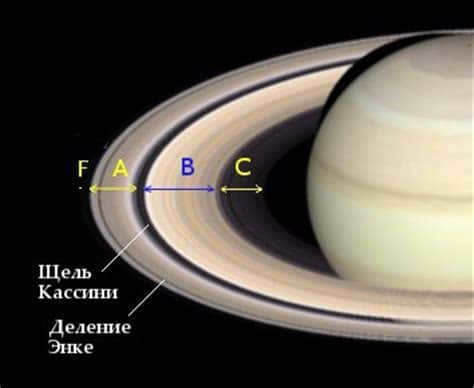
Cassini’s gap and the rings of Saturn
After Cassini’s exploration, there was a lack of significant data about Saturn for nearly 150 years.
However, by the late 18th century, an Englishman named William Herschel made two more major discoveries: Enceladus and Mimas. Subsequent findings included Hyperion and Theba, the only irregular satellite that also orbits in the opposite direction.
In the mid-20th century, Gerard Kuiper made a groundbreaking discovery by identifying the unique phenomenon of an atmosphere on Titan.
Origin of the name of the planet
The planet derives its name from the ancient Romans. Back then, all planets were named after gods, and Saturn was no exception.
Who was the planet Saturn named after?
Saturn is a modified form of the name Cronus, the ruler of the Titans. These celestial bodies were referred to as asters – wandering stars. Due to the limitations of technology at the time, the rings around Saturn were not visible, so it was perceived as a large celestial body with two “orbs” – and according to myth, the god Cronus held a sickle in one hand and ears in the other.
Saturn is a modified form of the name Cronus, the ruler of the Titans. Interestingly, Rhea was Cronus’ wife, and Jupiter, Ceres, and Veritas were their children.
The distance between the Sun and Saturn is approximately 1,430 million kilometers, and it takes about 29.5 Earth years for the giant planet to complete one orbit around the star. Interestingly, Saturn actually rotates on its axis faster than it orbits around the Sun.
Saturn is the sixth planet from the Sun, and it is situated between Jupiter (the fifth planet from the Sun) and Uranus (the seventh planet from the Sun).
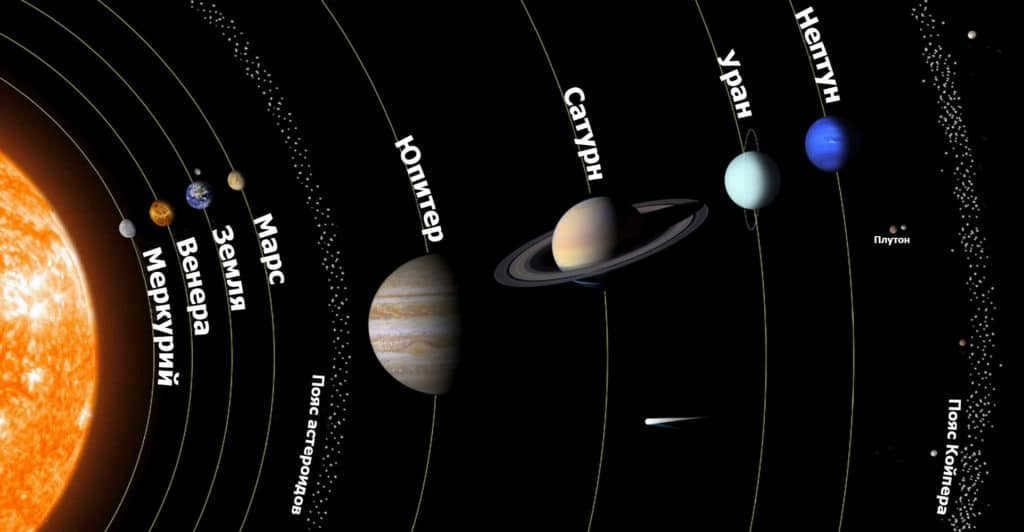

The planet Saturn has always captivated the attention of astronomers due to its remarkable feature – its rings. These rings are what sets Saturn apart from its celestial sibling, Jupiter. They are truly a sight to behold and a dream for any stargazer. Each astronomer who directs their telescope towards Saturn takes great care in observing and examining these rings, seeking to uncover their unique characteristics and intricate details. Below is a compilation of photographs showcasing Saturn’s rings, providing a glimpse into the number, size, and distance of each ring from the planet itself.
| D ring | 67 000—74 500 | 7500 |
| C ring | 74 500—92 000 | 17500 |
| Colombo Gap | 77 800 | 100 |
| Maxwell’s Gap | 87 500 | 270 |
| Bond’s Slit | 88 690—88 720 | 30 |
| Dave’s Slit | 90 200—90 220 | 20 |
| B ring | 92 000—117 500 | 25 500 |
| Cassini Fission | 117 500—122 200 | 4700 |
| Huygens Slit | 117 680 | 285-440 |
| Herschel Slit | 118 183—118 285 | 102 |
| Russell Slit | 118 597—118 630 | 33 |
| Jeffreys Slit | 118 931—118 969 | 38 |
| Kuiper Shield | 119 403—119 406 | 3 |
| Laplace slit | 119 848—120 086 | 238 |
| Bessel’s slit | 120 236—120 246 | 10 |
| Barnard’s slit | 120 305—120 318 | 13 |
| A ring | 122 200—136 800 | 14600 |
| Enke’s slit | 133 570 | 325 |
| Keeler slit | 136 530 | 35 |
| Roche fission | 136 800—139 380 | 2580 |
| E/2004 S1 | 137 630 | 300 |
| E/2004 S2 | 138 900 | 300 |
| F ring | 140 210 | 30-500 |
| G ring | 165 800—173 800 | 8000 |
| E ring | 180 000—480 000 | 300 000 |

This is a composite image showcasing the magnificent rings of Saturn.

Composite image showing the rings of Saturn. Ongoing.
The three primary sections of the rings are traditionally known as the outer A ring, middle B ring, and inner C ring. These sections can be observed using telescopes at the amateur level. There is also an additional inner D ring, only accessible to professional astronomers. There is evidence of outer E, F, G rings, which are extremely difficult to view from Earth.
The rings are separated from one another by gaps known as divisions. The most well-known divisions are the Encke Division and the Cassini Division.
The A ring displays a combination of white and yellow hues. When observed through a 200 mm aperture telescope and under optimal atmospheric conditions, it is discernible that the A ring is segregated into an inner section with a darker shade and an outer section with a lighter shade.
In a professional 300mm telescope, the Enke Complex (Dividing) serves as the demarcation line between Saturn’s outer ring zones. It also enables the identification of the “Keeler division” situated on the outer periphery of the A ring. This division exhibits a steel-colored tint.
The B ring is conventionally partitioned into two sections, namely the inner and outer halves. The outer half is particularly prominent, showcasing the most significant details. It is adorned in pure white, while the inner half bears a yellowish hue. Certain astronomers have noted periodic darkening of portions of the inner ring, attributed to even darker radial spokes.
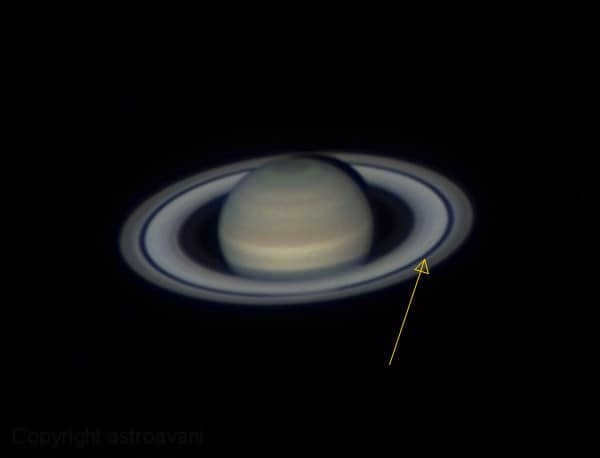

The division of Cassini is easily distinguishable.
The annular gap of Cassini, which opens wide, can be observed clearly through a 60-mm telescope. In this perspective, it appears as a thin band of dark gray color. When the atmospheric conditions are optimal, the Cassini Gap becomes visible when the rings are slightly ajar. At that point, it takes on the appearance of curved lines flanking the planet.
How to observe the planet through a telescope
Binoculars can be used to see Saturn’s rings – they appear as small extensions. In a telescope with a diameter of 60-70mm, the rings around the planet’s disk are clearly visible, and even the Cassini gap can be observed when the rings are moderately or fully open.
To observe the belt of massive clouds, a telescope with a diameter of at least 100-125 mm is required, and for more detailed studies, a device of 200 m is needed.
In recent times, amateur astronomers also have access to telescopes with these specifications, as they allow for the examination of all the belts, zones, and points of planets, as well as the smallest details of the rings. If possible, it is recommended to choose apochromatic refractors as they provide excellent contrast and image quality.
However, at present, not everyone can afford such an expensive telescope.
For observing Saturn, the ideal telescope is the APO killer system Maksutov-Kassegren, which was specifically designed for observing the planet.
Telescopes with a central screen are not recommended because, although they have a large lens diameter, they disrupt color contrast.
Due to the abundance of detail in the Saturn system, manually operating the telescope is not ideal for observing it in detail. It is better to equip yourself with a Go-To mount or a clockwork mount.
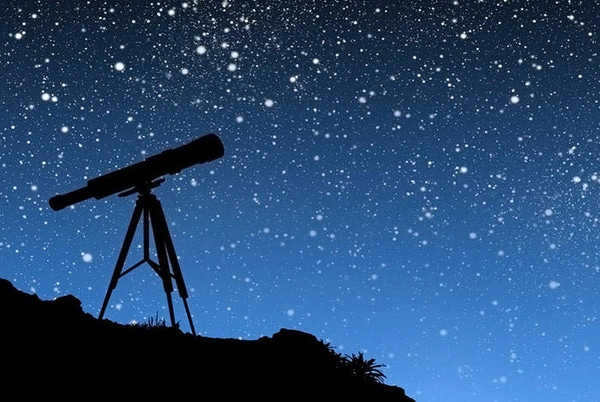
How to observe Saturn using a telescope
To enhance the visibility of Saturn and create more contrast, it is recommended to utilize the following filters:
How to locate the planet in the celestial sphere
To locate Saturn in the celestial sphere, it is necessary to analyze a stellar chart: it is constantly in motion and not always observable during nighttime. Then, find a spot where city lights won’t interfere with your observations.
Utilize a map to determine the position of the ecliptic, an imaginary line passing through the zodiac constellations that aids in determining the planets’ locations. In the region of the celestial sphere where Saturn is expected to be, one should search for a shining star (and planets appear as stars to the naked eye) that remains steady without flickering – this will be the desired planet.
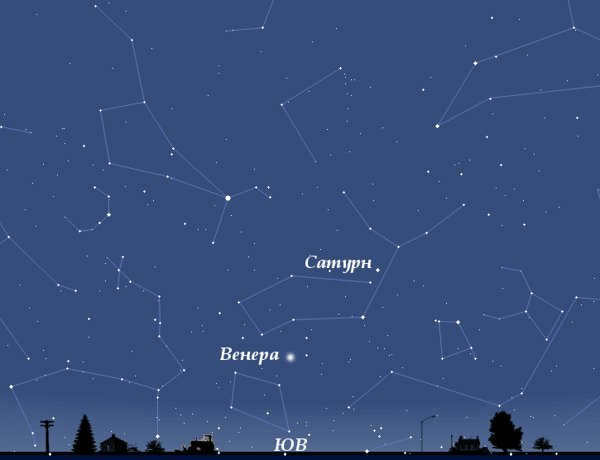
Why are Saturn’s rings not visible through a telescope?
During the opposition, when the planets are aligned in a straight line with the Earth and the Sun, and the Earth is positioned between them, Saturn’s rings cannot be seen through a telescope. This phenomenon occurs because Saturn takes approximately 29.5 Earth years to complete one revolution around the Sun. Every 13.75 and 15.75 years, the rings of Saturn become invisible from our perspective. The most recent occurrence of this phenomenon was in 2009.
Vanishing of Saturn’s rings
Saturn completes its orbit around the Sun in a span of 29.5 years. And during this cycle (after approximately 13.73 and 15.75 years), Saturn’s majestic rings transform into a nearly imperceptible belt, aligning its edge towards the planet. Witnessing this extraordinary celestial event is a true delight for astronomers fortunate enough to possess a 150mm telescope. Moreover, if one is equipped with a lens exceeding 300mm, they can meticulously observe the gradual disappearance of the rings. In particular, they can closely monitor the irregular vanishing of the rings, accompanied by the emergence of small, enigmatic dark patches.
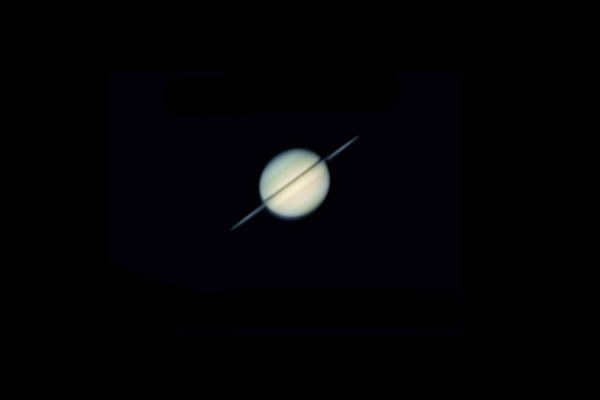
What are some fascinating sights to behold on Saturn?
The composition of Saturn’s surface primarily consists of gases, rendering its atmosphere the primary focus of observation. However, the intricate details of its atmosphere are not as easily discernible in comparison to Jupiter. This is mainly because Saturn is situated at a greater distance and is enveloped in a dense mist composed of vaporized gas.
If you’re observing Saturn through a telescope for the first time, initially you might only be able to discern its general shape. However, with careful observation, you’ll begin to notice distinct bands of contrasting colors. These bands are known as belts and zones, and in total, there are six of them.
Of particular interest is the equatorial zone. Within this zone, vigorous storms frequently occur, characterized by their high velocities. These storms manifest as bright white spots on the planet’s surface. This phenomena can be explained by the rise of heat from Saturn’s interior, along with the presence of ammonia. As a result of these processes, ice crystal clouds form in the atmosphere due to the cold air. These clouds emit the luminous light that we perceive from Earth.
Studying the ring system
Saturn has captured the fascination of astronomers due to its magnificent ring system, which is often hailed as the crown jewel of our solar system. When observing the rings through a telescope, one will notice distinct sections – an outer region with a shimmering metallic hue, a brighter middle region, and a darker inner region. These sections are separated by numerous gaps, with two of the most notable ones being the Cassini Gap, which traverses the center of the ring system, and the Enke Fission located at the outermost edge.
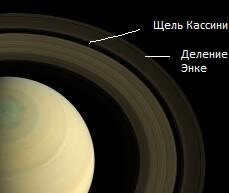
Twice during a complete revolution around the sun (which takes approximately 29.5 years), the rings of Saturn are no longer visible from Earth. This extraordinary event occurs at intervals of about 13.75 and 15.75 years. Instead of the rings, the telescope reveals faint bands during these periods. The next occurrence of this disappearance is anticipated to happen around 2024-2025.
Earth’s Distance from Saturn
The distance between Earth and Saturn is in a constant state of flux, as the planets within our solar system follow elliptical orbits. Scientists have determined that the minimum recorded distance from Earth to Saturn measures 1,195,000,000 kilometers, while the maximum distance stretches to 1,600,000,000 kilometers. On average, the distance is estimated to be around 1,280,000,000 kilometers.
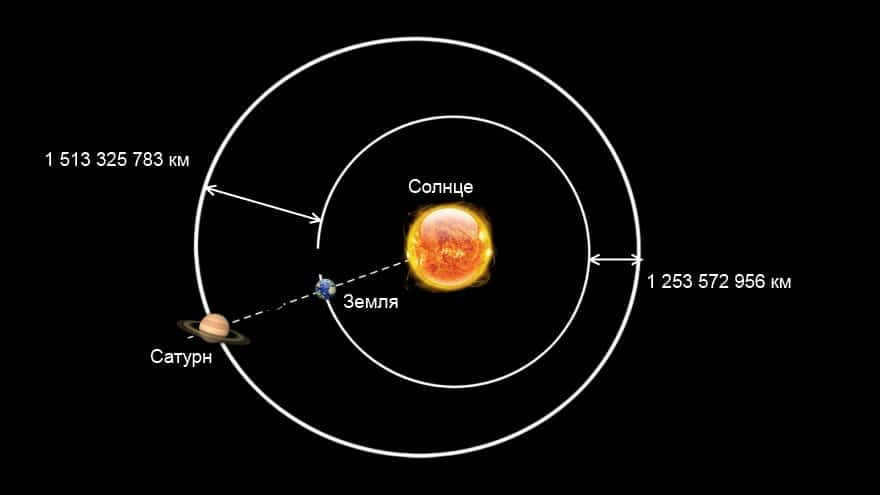
When it comes to finding Saturn in a telescope, one of the most fascinating aspects is observing the distance from Earth to Saturn.
Exploring the mesmerizing shadow cast by the rings on Saturn’s disk
When observing Saturn through a telescope, the shadow of its rings presents itself as a captivating thin band of dark gray. This band can be seen at the point where Saturn’s disk intersects with its magnificent rings. The position of this shadow varies depending on the inclination of the rings, adding to the allure of observing Saturn through a telescope.
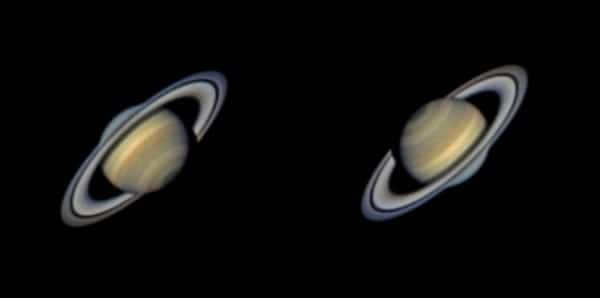
The rings of Saturn cast a shadow on the planet’s disk
Distance from the Sun
Saturn is located at an average distance of 1.4 billion meters from the Sun. Similar to Earth, this distance varies throughout the year.
The farthest distance from the Sun is 1,510,000,000 kilometers, while the closest distance is 1,350,000,000,000 kilometers.
Performing calculations with such large numbers can be cumbersome, so scientists utilize a unit known as an astronomical unit. One astronomical unit is equivalent to 149,600,000,000 km, which means Saturn’s average distance from the Sun is 9 astronomical units.
How much time does it take to travel from Earth to Saturn?
The distance between Earth and Saturn is an average of 8.5 astronomical units. With a vehicle capable of reaching speeds of up to 300,000 kilometers per second, the journey would take approximately an hour and a half. However, modern spacecraft usually take an average of 6-7 years to reach Saturn. For example, Pioneer 11 completed the journey in 6 and a half years, Voyager 2 took 4 years, Cassini took a lengthy 6 years and 9 months, and New Horizons set a record by reaching Saturn in just 2 years and 4 months.
The actual travel time depends on various factors, including the purpose of the mission and the propulsion system of the spacecraft. It is worth noting that Voyager 1 and Voyager 2 traveled directly towards Saturn, while Pioneer 11 and Cassini utilized the gravitational pull of other planets to assist them in reaching their destination.
Saturn’s luminosity
An intriguing aspect pertains to the luminosity of Saturn. Several months prior to reaching opposition, the planet’s luminosity measures approximately 0.5m. However, during the proximity of opposition, the planet’s luminosity can unexpectedly and noticeably surge to -0.55m! This phenomenon is known as an opposition burst and is attributed to Saturn’s expansive rings.
These rings undergo a brightening process during a confrontation. The reason behind this lies in the fact that they consist of trillions of ice flakes, dust particles, and pebbles orbiting the planet. These particles have irregular and rough shapes, resulting in the casting of shadows. When Saturn is near opposition, the rings are directly illuminated by light (from our perspective on Earth), and intense backscatter amplifies their luminosity to a significant extent.
To witness this extraordinary phenomenon, you can personally experience it by observing the rings of Saturn through a telescope on consecutive nights or by observing the brightness of Saturn without any optical aids.
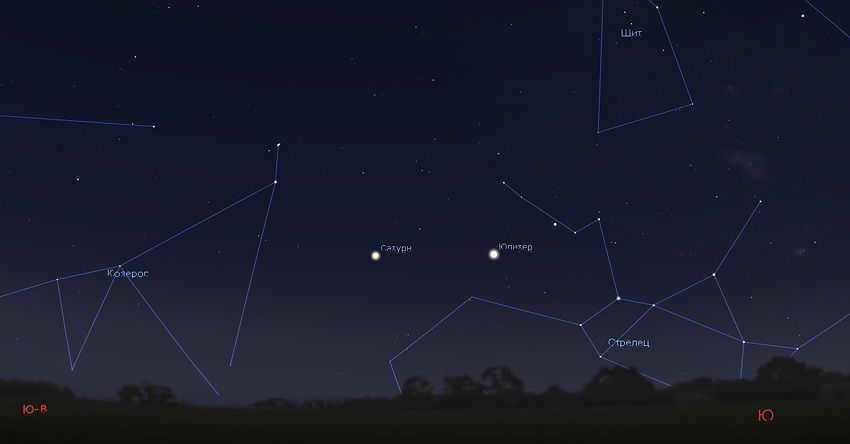

In the summer of 2020, spotting Saturn in the night sky is a breeze, especially with the presence of a luminous Jupiter. These two planets are in close proximity to each other, making them even easier to locate. The accompanying image is specifically captured from the latitude of Moscow, as well as the middle strip of Russia.
If you utilize a 60-70 mm refractor or a 70-80 mm reflector in order to observe the celestial sky, you can witness craters on the Moon that have an 8 km diameter, faint stars with a magnitude of up to 11, the rings of Saturn, Uranus, and Neptune, as well as forming stars, the polar caps of Mars, and other various objects.
White spot on Saturn’s rings
Occasionally, an observer may detect a temporary brightening in certain areas of Saturn’s rings. This resulting spot is the most luminous feature on the planet’s surface, despite it being merely an optical illusion.
Additional gear
If you want to catch a breathtaking view of Saturn, consider investing in a set of color filters. These filters are designed to enhance the contrast of specific features, allowing you to see the planet in all its glory.
What to Look for When Observing Saturn
Saturn, a gas giant, provides a fascinating subject for observation, especially when studying its atmosphere, which bears a striking resemblance to that of Jupiter. However, the contrast and level of visible detail on Saturn is somewhat diminished compared to its counterpart. This can be attributed to Saturn’s greater distance from Earth and the presence of ammonia in its warm interior. As the ammonia rises into the upper atmosphere, it freezes and creates a dense fog that effectively obscures the finer structures of the planet’s zones and belts.
Initial observations of Saturn through a telescope may not elicit much excitement, as it primarily appears as a grayish disk surrounded by rings. However, observers should remain patient and persistent in their research. Over time, they will start to discern light bands, known as zones, and dark areas, known as belts, on the planet’s disk. Utilizing a map of Saturn can greatly aid in identifying and appreciating these incredible features.
Information about the surface of Saturn based on the size of your telescope
Each planet within our solar system possesses its own distinct characteristics, but Saturn stands out as an exceptionally extraordinary entity due to its magnificent rings. Even seasoned astronomers find themselves awe-struck by its captivating appearance. With just a bit of exertion, it is possible to observe Saturn’s striking rings even with compact binoculars. When viewed through these optical instruments, the rings manifest as petite protrusions on either side of the planet.
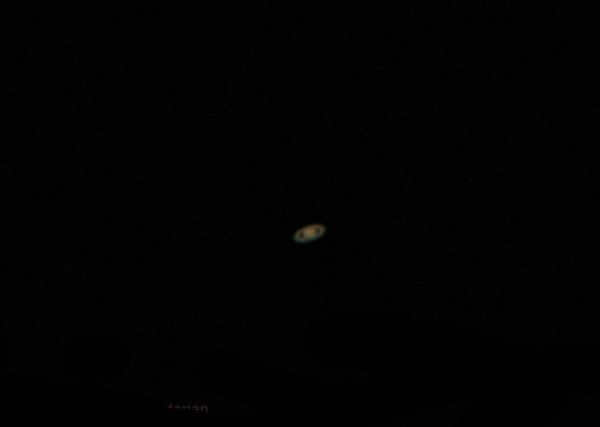
Observing Saturn through a telescope with a lens size of 60-70mm allows for a clear view of the planet’s distinct disk and its iconic rings, although no specific details can be observed. When the rings are fully open, it is possible to see the Cassini gap.
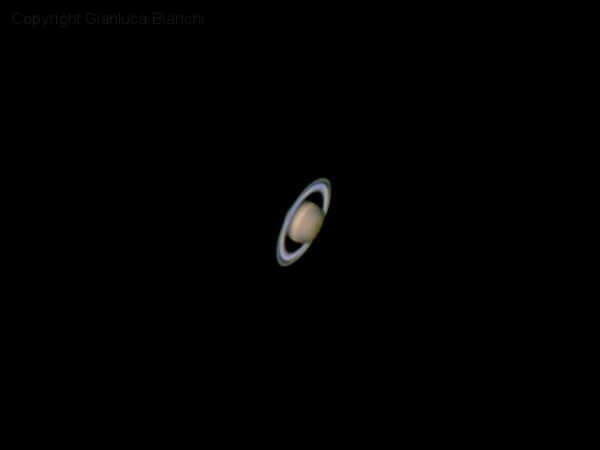
Saturn observed using a 127 mm telescope
By using a telescope equipped with a lens ranging from 100-125 mm, one can observe the cloud belts of Saturn. However, for more advanced observations, it is recommended to use a telescope with an aperture of at least 200 mm. This type of telescope, which is now accessible even to amateur astronomers, allows for the observation of light and dark spots, zones, and stripes on the planet’s surface. Additionally, it enables the examination of certain details within the structure of Saturn’s rings.
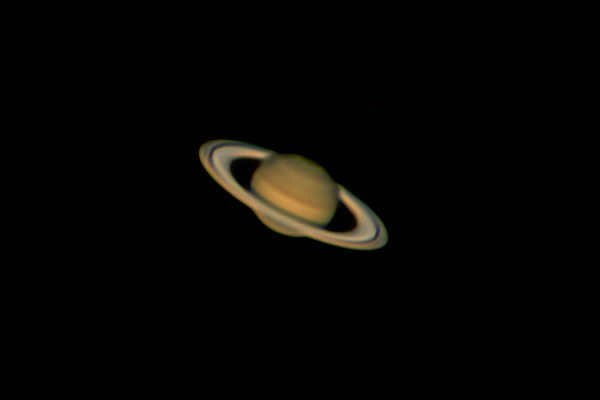
Observing Saturn using a 200-mm telescope
Discovering the planet
Key facts
Saturn is known as the sixth planet from the Sun and ranks as the fifth most luminous planet in our Solar System.
Jupiter, Saturn, Uranus, and Neptune belong to the category of gas giants due to their predominant composition.
Unlike Earth, Saturn lacks a solid surface and boasts a mass that is 95 times greater than our planet’s.
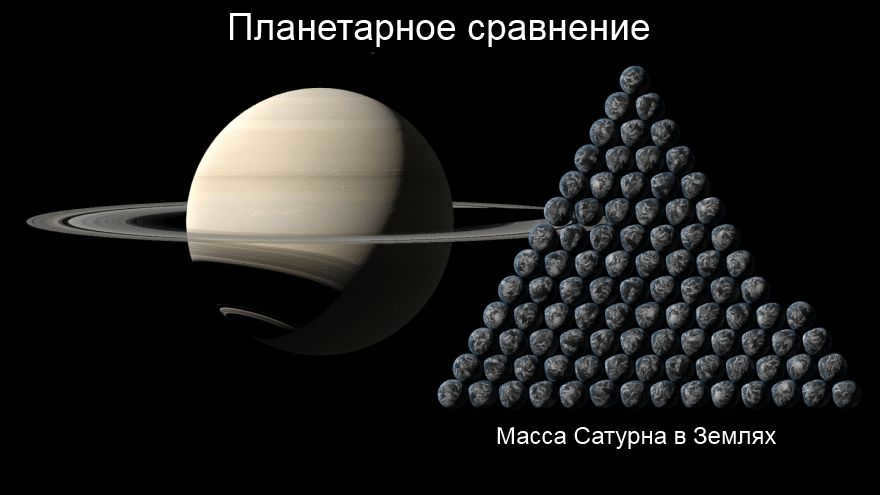
When it comes to Saturn’s mass on Earth, it’s worth mentioning that its density is a mere 0.687 grams per cubic centimeter, which is even lower than that of water. The composition of Saturn consists of layers of gas, with hydrogen in a metallic form closer to the core, and a luminous substance at the planet’s center. The rings are comprised of coal dust and shards of ice.
Titan, the planet’s only moon with an atmosphere, is home to methane lakes and frozen nitrogen mountains. Scientists find Titan particularly fascinating due to its potential habitability. Out of the 150 known moons, only 53 have been assigned names, mostly derived from Greek deities.
Physical features of Saturn
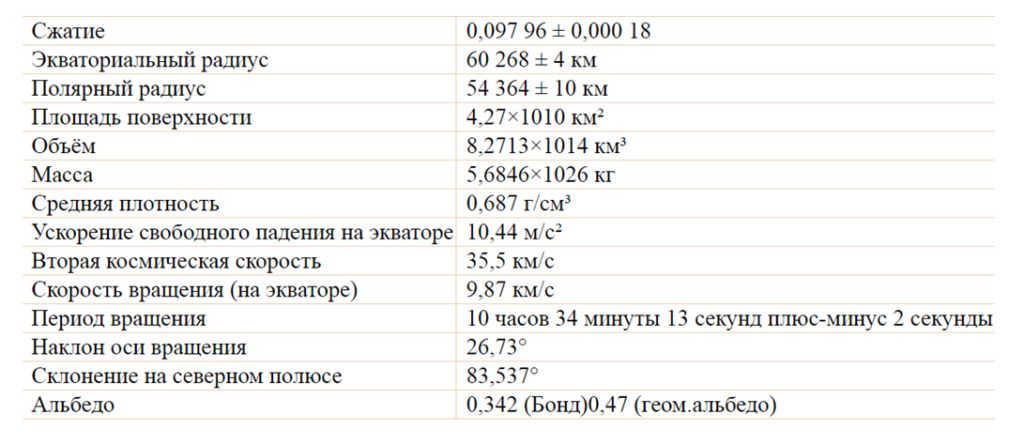
Trips to the planet
Spacecraft were sent to Saturn in the late 20th century, with a total of four flights: Pioneer-11 launched in 1979 and captured the first photographs of Saturn and its satellites from a distance of 20,000 km, while also determining Titan’s temperature (-179 °C).
A year later, Voyager 1 began its expedition, followed by Voyager 2 9 months later. These missions provided the first high-quality images of the planet, its rings, and its satellites.
As a result of these journeys, five more satellites of the gas giant were discovered, and the exact number of rings was determined to be 7.
In July 2004, the Cassini-Huygens spacecraft approached Saturn.
Saturn can be best observed using binoculars or a telescope. The ideal time to see Saturn is in August 2021! Currently, it can be seen to the right (south) of bright Jupiter above the southern horizon. In clear weather, both planets can be clearly visible throughout the night.
Today, on July 20, marks the day of the 2020 Saturn opposition (or as it is also known, opposition). As we are aware, Saturn is the farthest planet that can be seen with the naked eye in our sky. It is also one of the most remarkable planets! Even with the smallest telescopes, you can observe its magnificent rings. It is truly a fantastic sight, and it’s hard to fathom that a giant sphere, surrounded by a thin ring resembling a vinyl disk, exists somewhere in the vast expanse of space.
The Saturn opposition is a significant event in the planet’s journey across the sky. It is a special date because during the opposition:
However, the appearance of the planet during the opposition is quite similar to that on surrounding days and even weeks. As Saturn and Earth smoothly approach and move away from each other, the changes in brightness, motion speed against the backdrop of constellations, and overall visibility of the ringed giant are also smooth and hardly noticeable to the naked eye.
In fact, the opposition marks the beginning of a whole month of optimal Saturn visibility! Throughout this period, the planet will not only appear as bright and large as possible when observed through telescopes, but it will also rise earlier and earlier, reaching its highest point above the horizon where the conditions for observation are most favorable.
Where can you find Saturn in the sky during July-August 2020?
Once the evening twilight sets in, direct your gaze towards the southeast. To do this, simply position yourself with your back facing the fading daylight. (Keep in mind that Saturn is currently in opposition with the Sun?) You can also use the Summer Triangle, a prominent formation consisting of the three brilliant stars Vega, Deneb, and Altair, as an additional guide. This formation can be found in the southeastern part of the sky as twilight approaches. Vega and Deneb are situated almost directly overhead, while Altair is positioned halfway between the zenith and the horizon.
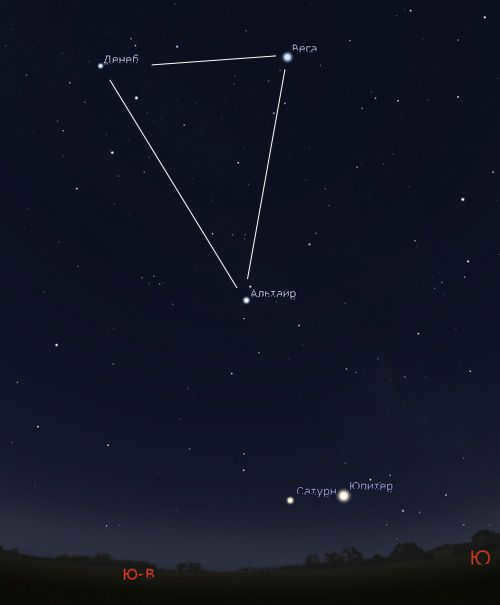
In the July sky of 2020, you can observe the Summer Triangle alongside the planets Jupiter and Saturn. This beautiful celestial display was captured in the image above using Stellarium.
Just below the Summer Triangle, you will notice two bright stars that appear close together and at a similar height above the horizon. However, these “stars” are not stars at all, but rather planets. The one on the right is particularly brilliant, resembling a distant spotlight. This is Jupiter, which recently reached its opposition. On the left, you will find Saturn, shining with a brightness comparable to the star Vega in the Summer Triangle.
The Brightness of Saturn
An intriguing aspect concerns the luminosity of Saturn. A few months prior to the opposition, the planet’s brightness measures approximately 0.5 m. However, in close proximity to the opposition, the planet’s brightness can experience a sharp and noticeable surge, reaching -0.55 m! This phenomenon is referred to as the “opposition jump,” and it occurs due to the planet’s expansive rings.
It is the rings themselves that become more radiant during the opposition. But why? The explanation lies in the fact that they consist of trillions of ice flakes, dust, and pebbles that orbit the planet. These particles possess irregular and rough shapes, resulting in the casting of shadows. When the opposition occurs, light directly illuminates the rings (from the perspective of us Earth inhabitants), and the strong backscattering effect causes their brightness to increase significantly.
To witness this intriguing phenomenon, you can personally experience it by observing the rings of Saturn through a telescope on consecutive evenings or by monitoring the brightness of Saturn with your naked eyes.
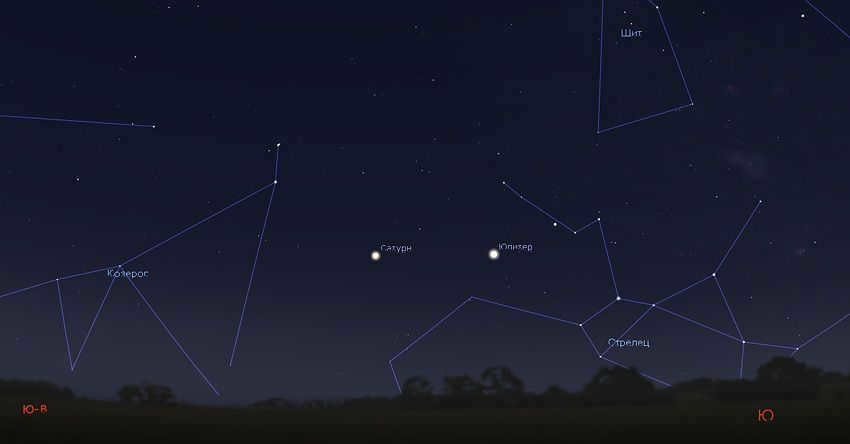
During the summer of 2020, locating Saturn in the night sky is a simple task due to its close proximity to the bright Jupiter. This image shows the position of the planets as seen from Moscow and the middle region of Russia. Image source: Stellarium
Observing Saturn through a telescope
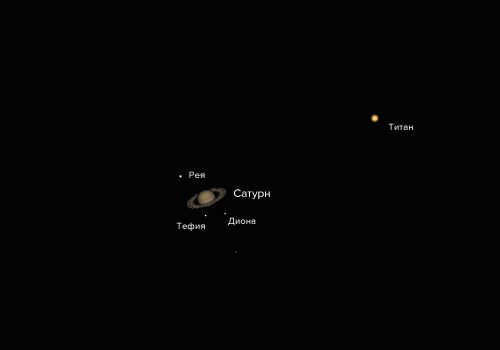
This is an approximation of Saturn’s appearance when observed with a non-professional telescope. Its most prominent moons are displayed alongside it. Image: Stellarium
During the summer of 2020, Saturn can be found in the Sagittarius constellation, which is the southernmost constellation in the Zodiac. Consequently, it will appear low on the horizon. This will hinder the ability to make detailed observations of Saturn through a telescope, as the Earth’s atmosphere will distort fine features. However, you will still be able to see Saturn’s flattened shape, its stunning rings, and its largest moon, Titan.
Saturn has a visible diameter of 19 arc seconds, and when combined with its rings, it measures 42″! The rings, along with the planet’s pole, have a tilt of 21°, making them easily visible. When observing Saturn through a telescope with an aperture of 80 mm or greater and under favorable atmospheric conditions, you can even spot the Cassini gap that separates the rings.

We are fortunate to have an exceptional individual in Omsk, Vladimir Krupko, who is not only a skilled astronomer but also an incredibly passionate and altruistic individual. On a regular basis, he arranges excursions outside the city for anyone interested in “observing the celestial bodies,” utilizing an impressively potent telescope. The remarkable aspect is that these excursions are completely free! Furthermore, he shares a wealth of intriguing information and even organizes a cozy tea gathering by a crackling fire to ensure everyone stays warm. It truly creates a welcoming and intimate atmosphere, if I may add.
After joining the group, we had an incredible time and gained many new experiences! While our main goal was to observe the meteorite, we also had the opportunity to marvel at the Moon, Saturn, and Jupiter, which we gladly took advantage of. It’s worth mentioning that despite my nearsightedness, I was able to clearly see Saturn’s ring and at least two of Jupiter’s satellites (Io and Callisto, if I remember correctly).
When I captured a photo of Saturn using a 300mm SLR lens, I didn’t have high expectations. To my surprise, however, the silhouette was still recognizable.

It is your responsibility as the oldest to handle the situation!

A patient dog is biding his time
The teacher is close by – no need to fret.
Peter was enveloped by rain and thunderstorms during the night.
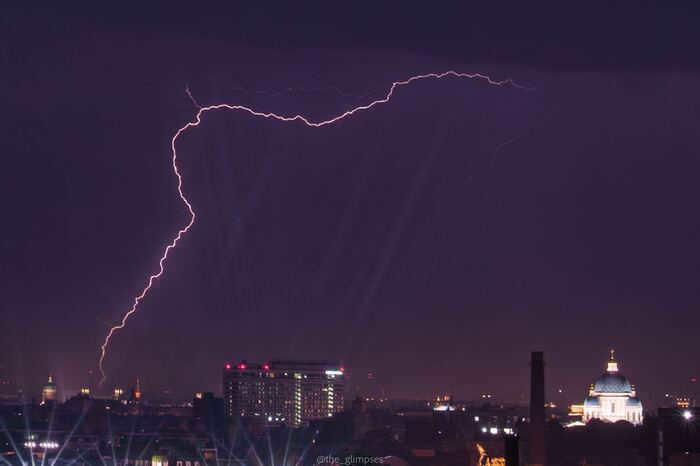
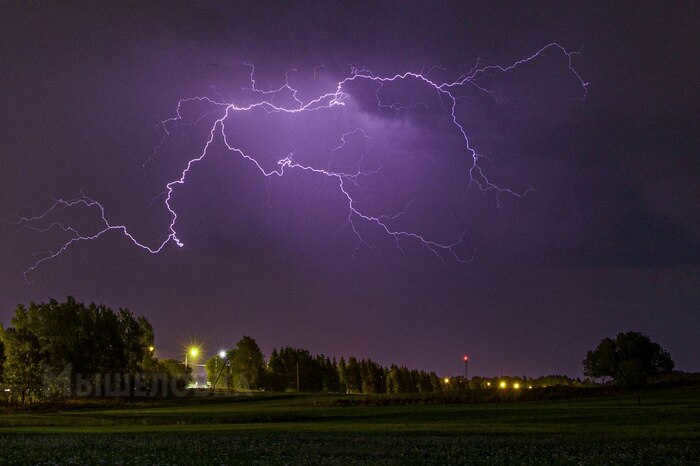
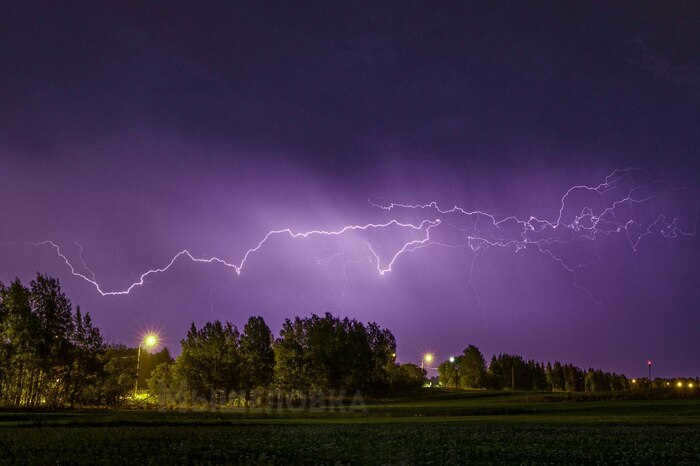
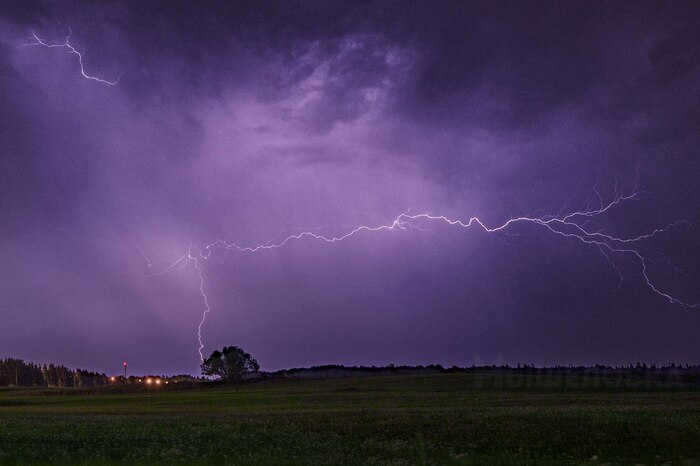

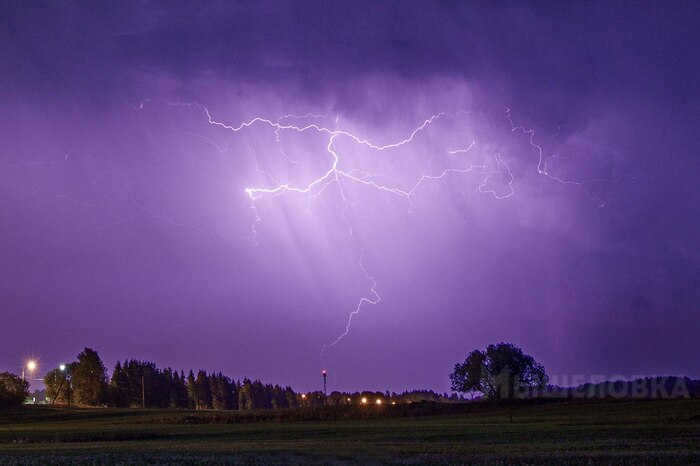
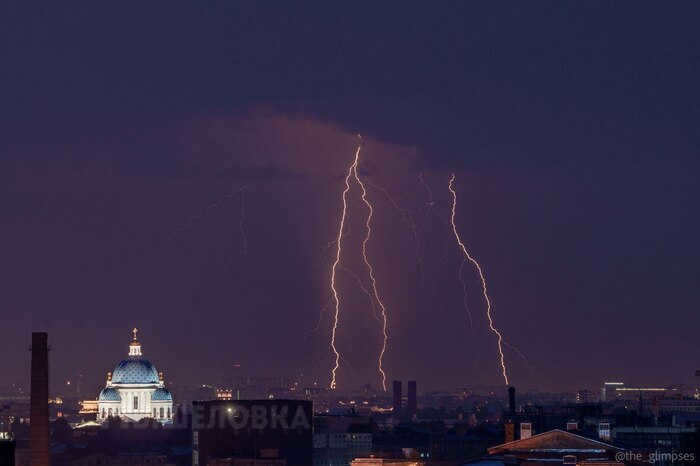

Continued from “We have a new feline friend. Someone abandoned her on the street, where she fell ill. Yesterday, an urgent blood transfusion was necessary.”
Greetings to all from the adorable white kitten. Following the successful blood transfusion, she has begun to eat heartily and has even gained some weight. We have conducted a comprehensive blood test, including tests for VIC and Leukemia.


There is a Telegram channel called iRescue where 550 tails have found their new homes. You can find it at https://t.me/s/irescue. If you prefer to contact via email, you can reach them at [email protected]. Additionally, if you would like to make a donation, you can do so through this link: https://pay.cloudtips.ru/p/0649c6db. Finally, there is an album on VK with pictures of animals looking for a home in SPB and LO. You can find it here: https://vk.com/album-203932626_280491845.

“Failing is the first step towards winning” ©

This was the final straw of patience
Da Vinci Bridge
Da Vinci Bridge – a bridge with a unique design. Leonardo intended to construct it across the Golden Horn Bay in Istanbul. – it was commissioned by the Turkish sultan Bayazet II. However, for reasons that are not fully understood, the Ottoman ruler abandoned the project. For a long time, there were only legends about this plan of the great master, but later researchers discovered a small drawing of the design which is depicted in the video.
Update:
Although Da Vinci’s drawings of this bridge were found, it appears that a different bridge design was used for Sultan Bayazat in the photo below.
Thanks to everyone who left comments below the post with this information!

Feeling parched
What a remarkable response
The bay in Cape Cod, Massachusetts is graced with the stunning sight of the Milky Way rising

An Out-of-this-World Experience! The Astro Journey of the “Look at the Stars” Initiative Attracted Approximately 1400 Astronomy Enthusiasts
A grand astronomical event organized by the “Look at the Stars” project took place near Orenburg. Attendees had the opportunity to witness the Perseids meteor shower, the most intense meteor shower of the year. Around 1400 individuals gathered to marvel at the celestial spectacle and make wishes under the open sky. This turnout set a new record for the project’s entire history. Since 2016, a community of amateur astronomers has been convening at this location to observe celestial objects and indulge in stargazing.
One of the most vibrant and colorful astronomical events of the summer is the Perseid meteor shower, which can be seen in the August sky. This dazzling display occurs when the Earth passes through a cloud of dust particles released by the Swift-Tuttle comet. Over the weekend, the meteor stream reached its peak, with an estimated density of around 100 meteors per hour.
– Thanks to a dark sky devoid of moonlight, we were able to witness numerous brilliant meteors from the Perseid stream. Each meteor was met with thunderous applause! To enhance the experience, live space music played in the background. It has always been our dream to merge space ambient music with the awe-inspiring starry sky! – shared Sergey Medvedev, the project’s organizer and photographer.
The stargazing event commenced with an extensive presentation on meteors, meteorites, asteroids, and comets. The event coordinators acquainted the citizens of Orenburg with the most renowned celestial objects that make their way to our planet, and even divulged details about the monetary value of these “rocks” and the locations where they can be purchased.

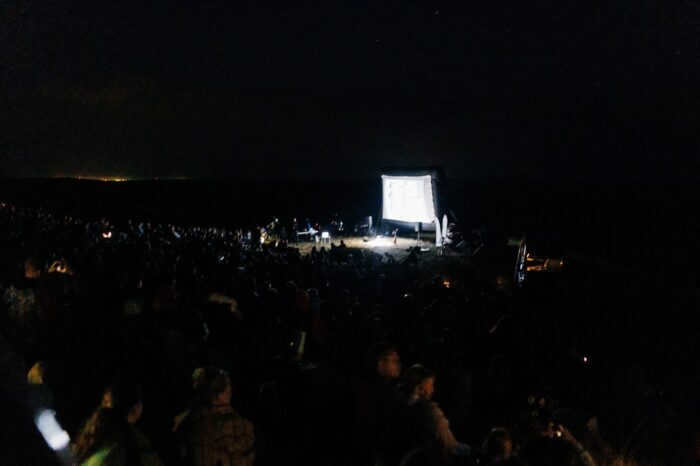



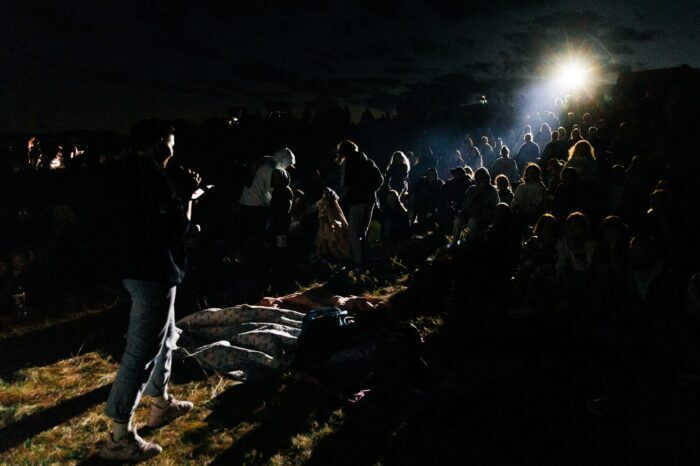

Following the lecture, the attendees were treated to a fascinating journey through the celestial realm before being granted unrestricted access to the impressive array of telescopes. On this particular evening, the astropolis showcased a total of eight different telescopes, each offering its own unique perspective. Among the most remarkable were the Meade LX850 and the Dob 16, both of which were skillfully transported to the venue by the dedicated team at the Center for Gifted Children “Gagarin”. Our project has developed a close bond with these talented youngsters, and it is not the first time that we have extended an invitation for them to partake in this awe-inspiring astro-event. The glade was truly transformed into a veritable astronomical extravaganza.
– The most heartwarming moment of the astrovizod occurred when we requested everyone on the glade to illuminate their phone lanterns in their hands. Our intention was to gauge the number of people who came to see us, as a similar event last year attracted around 1000 individuals. When the lanterns began to glow, our hearts skipped a beat, as we did not anticipate such a large audience, filled with enthusiasm and even children who listened attentively to our lecture. It was an incredible feeling, and we extend our gratitude to each and every person in attendance. We felt your warmth there on the clearing as you applauded the stargazing and made wishes with delight. We are truly grateful! – exclaimed Tatyana Gavrish, the project organizer and Orenburg Media editor-in-chief.
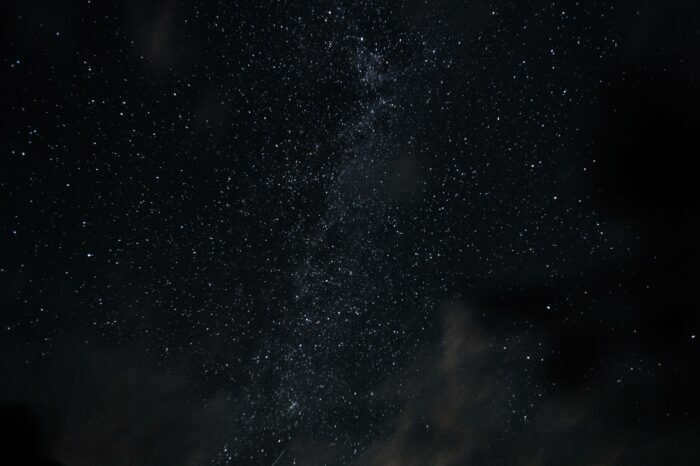



This year’s astro trip took on a fresh approach. Just before the lecture, the astro-event partner, Vostok-Auto, a renowned car dealership and the official dealer of Chery cars in Orenburg, organized a test drive of the brand-new Chery Tiggo 7 PRO MAX, a remarkable all-wheel drive family SUV. The location chosen by the group was truly breathtaking – situated amidst vast steppes and rolling hills. To enhance the experience, a delightful picnic and special souvenirs were provided to all participants of the test drive.




– The Orenburg branch of ISTC “Eye Microsurgery” provided excellent assistance during our event. We were able to fulfill our dream of bringing live sound and space music to the outdoor venue, surrounded by the open sky and stars! The ambient project “Eli Maclay” and musician Nikolai Cherepanov performed for all attendees, creating a celestial atmosphere. Kolya, our special guest and a rising star of the project, played a key role in establishing the cosmic ambiance at the astropolean. We believe that his music played a significant part in creating such a unique atmosphere, ” said Igor Komissarchik, the project organizer and editor-in-chief of “Orenburg Media.”
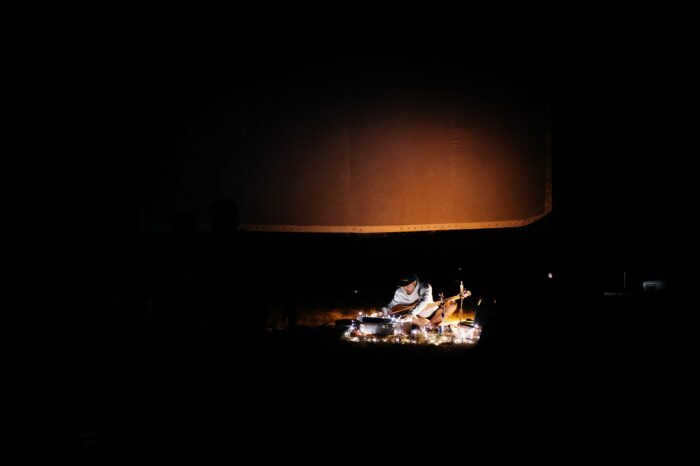
Get the latest updates on space news, stunning astrophotos, and fascinating star stories through the Telegram channel “Near Space” and the astro-community VKontakte.
Discover valuable insights about the current and projected position of Saturn in the solar system and the night sky, tailored to your specific location. Additionally, explore its apparent brightness, size, luminosity, and other intriguing details.
Current Position of Saturn in the Sky
The chart displays the elevation of Saturn above the horizon (—°) at different times of the day. The shaded sections ( ) indicate nighttime, while the dashed line ( — ) represents the present time.
Latest Updates on Saturn
An image of Enceladus’ massive plume has been captured by the “James Webb” telescope.
Astronomers theorize that Saturn’s rings are the result of a shattered icy satellite.
The “Hubble” telescope has concluded its annual survey of the gas giant planets.
Saturn’s core was surprisingly larger than anticipated.
The tilt of Saturn’s axis of rotation is explained by Titan’s migration.
On December 21, there will be a conjunction between Jupiter and Saturn.
The “Cassini” spacecraft has unveiled the longstanding mystery surrounding Saturn’s abnormal heating.
Japanese planetologists have unveiled the origin of Titan.
The enigma of the streaks on Saturn’s moon has been unveiled
The current position of Saturn in the solar system
The provided illustration displays the present whereabouts of Saturn, Earth, and the Sun, as well as their anticipated positions in one year.
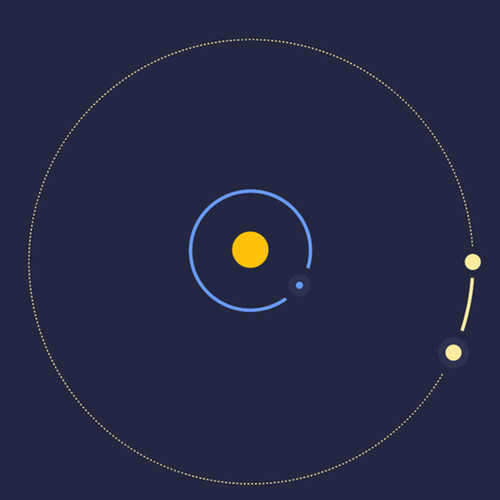
The current distance from Saturn to the Sun is
The current distance from Saturn to Earth is
This animation shows how a photon travels from Earth to Saturn at a speed of 299 792 458 m/sec. It will cover the current distance of 1312.9 million kilometers in 1 hour. 13 minutes.
The chart displays the fluctuation in the total number of hours per day ( , h) that Saturn spends in the sky before sunrise and after sunset on a specific day.
Saturn’s luminosity in the sky over the upcoming half-year
The graph illustrates the variation in Saturn’s luminosity (—) based on the stellar magnitude (m).

